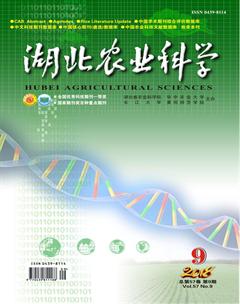不同環境因子對深圳海濱地木耳生長和多糖特性的影響
聶磊 楊小東 廖寶林
摘要:采用正交試驗分析了不同環境條件對念珠藻地木耳(Nostoc commune Vauch)生物量和多糖分泌的影響。結果表明,在適宜的溫度、光強、鹽度和UV-B處理對地木耳的生長、胞外多糖分泌及其抗氧化能力有明顯的促進作用。培養條件為光照強度100 μmol/(m2·s)、溫度30 ℃、NaCl濃度0 mmol/L和UV-B輻射強度10 kJ/(m2·d)時,地木耳有最大的相對生長率;光照強度200 μmol/(m2·s)、溫度35 ℃、NaCl濃度40 mmol/L和UV-B輻射強度20 kJ/(m2·d)時,胞外多糖的分泌強度最高,溫度和UV-B處理分別對相對生長率和胞外多糖含量的提高有顯著效果。
關鍵詞:地木耳(Nostoc commune Vauch);生長;胞外多糖;環境因子
中圖分類號:Q914.4 文獻標識碼:A 文章編號:0439-8114(2018)09-0058-04
DOI:10.14088/j.cnki.issn0439-8114.2018.09.013
Impact of Different Environmental Factors on Growth and Polysaccharides Characteristics of Nostoc commune Vauch From Shenzhen Seashore
NIE Lei1,YANG Xiao-dong2,LIAO Bao-lin2,HAN Jing1
(1.Faculty of Environmental Engineering,Shenzhen Institute of Information Technology,Shenzhen 518172,China;
2.Research Institute of Guangdong Ocean University in Shenzhen,Shenzhen 518120,China)
Abstract: Impact of different environmental factors on growth and polysaccharides characteristics of Nostoc commune Vauch from Shenzhen seashore were analysed by orthogonal experiment. The results showed that under the appropriate conditions of temperature,illumination intensity,inorganic salt and UV-B treatment,the relative growth rate(RGR),the content and the anti-oxidant capacity of extracellular polysaccharides were significantly stimulated. The culture conditions were that 30 ℃ temperature,0 mmol/L NaCl,100 μmol/(m2·s) illumination intensity and 10 kJ/(m2·d) UV-B treatment,the relative growth rate was the highest. When the conditions were that 35 ℃ temperature,NaCl concentration at 40 mmol/L,illumination intensity at 200 μmol/(m2·s) and UV-B treatment at 20 kJ/(m2·d),the extracellular po1ysaccharides concentration were the highest. The most significant factor for the relative growth rate(RGR) and EPSs were temperature and UV-B treatment,respectively.
Key words: Nostoc commune Vauch;growth;extracellular polysaccharides;environmental factors
地木耳即普通念珠藻(Nostoc commune Vauch),為一種世界廣泛分布的單細胞陸生固氮藍藻,美味可口、營養豐富。地木耳主要分布在富含鈣的石灰巖山區和喀斯特巖溶地帶,具有極強的抗旱、耐高溫高光等逆境適應能力,在生長繁殖過程中分泌大量具有生物活性的多糖物質是其抗逆性強的重要原因,尤其分泌的胞外多糖(Extracellular Po1ysaccharides,EPSs), 在環保、食品、醫藥等領域具有廣泛的應用前景[1]。迄今為止,國內外已對地木耳多糖有了大量的研究,主要集中在生物成分、活性及藥理性質等方面,對于地木耳是如何適應不同逆境條件以及在逆境條件下地木耳胞外多糖的分泌等問題鮮見報道[2]。因此,本研究通過分析不同光照強度(光強)、鹽度、溫度和UV-B條件下深圳海濱巖溶地區地木耳生長和多糖分泌的影響,以期為地木耳的生物多糖生理機制研究以及生物資源開發利用提供思路。
1 材料與方法
試驗用地木耳樣品2015年11月采集于深圳大鵬灣裸露的石灰巖上,采集時天氣晴朗,溫度為(25±1) ℃。從試管中挑取地木耳,滅菌3~4次后接種到三角瓶中,用滅菌好的BG11培養基培養,環境溫度控制為25 ℃,光強為50 μmol/(m2·s),光周期為12 h∶12 h的人工氣候箱內活化一周,每天早、中、晚各振蕩一次,避免藻種結塊生長,每隔2 d換一次水,通氣培養。不同環境因子設定條件:溫度分別設置25(T1)、30(T2)、35 ℃(T3)3個處理;光強處理分別為50(L1)、100(L2)和200 μmol/(m2·s)(L3);無機鹽處理在基礎培養基BG-11上,分別配置0(S1)、40(S2)和80 mmol/L(S3)濃度梯度的NaCl,調pH至8.0;UV-B輻射設置3個處理,即無輻射(U1)、10 kJ/(m2·d)的中度輻射(U2)和20 kJ/(m2·d)的高輻射(U3)。培養15 d后,測定生長和生理生化指標。

